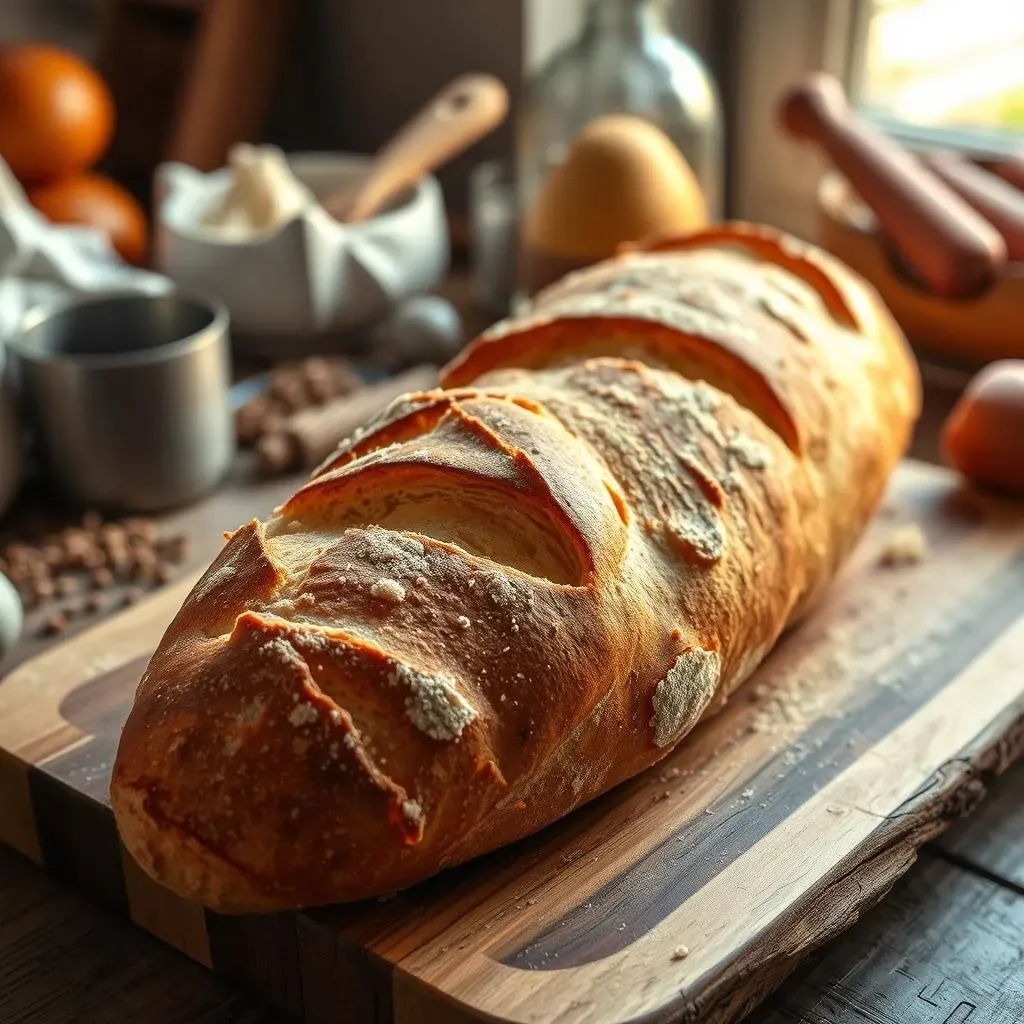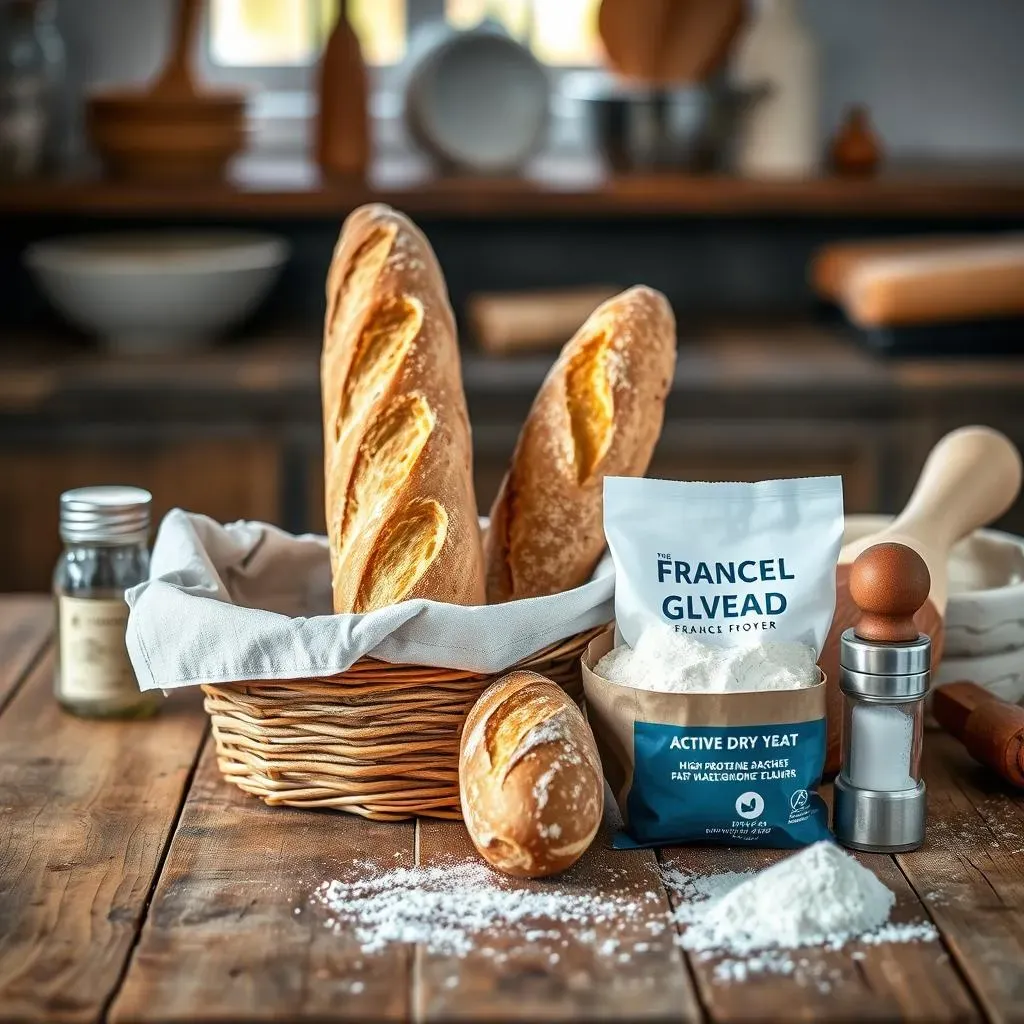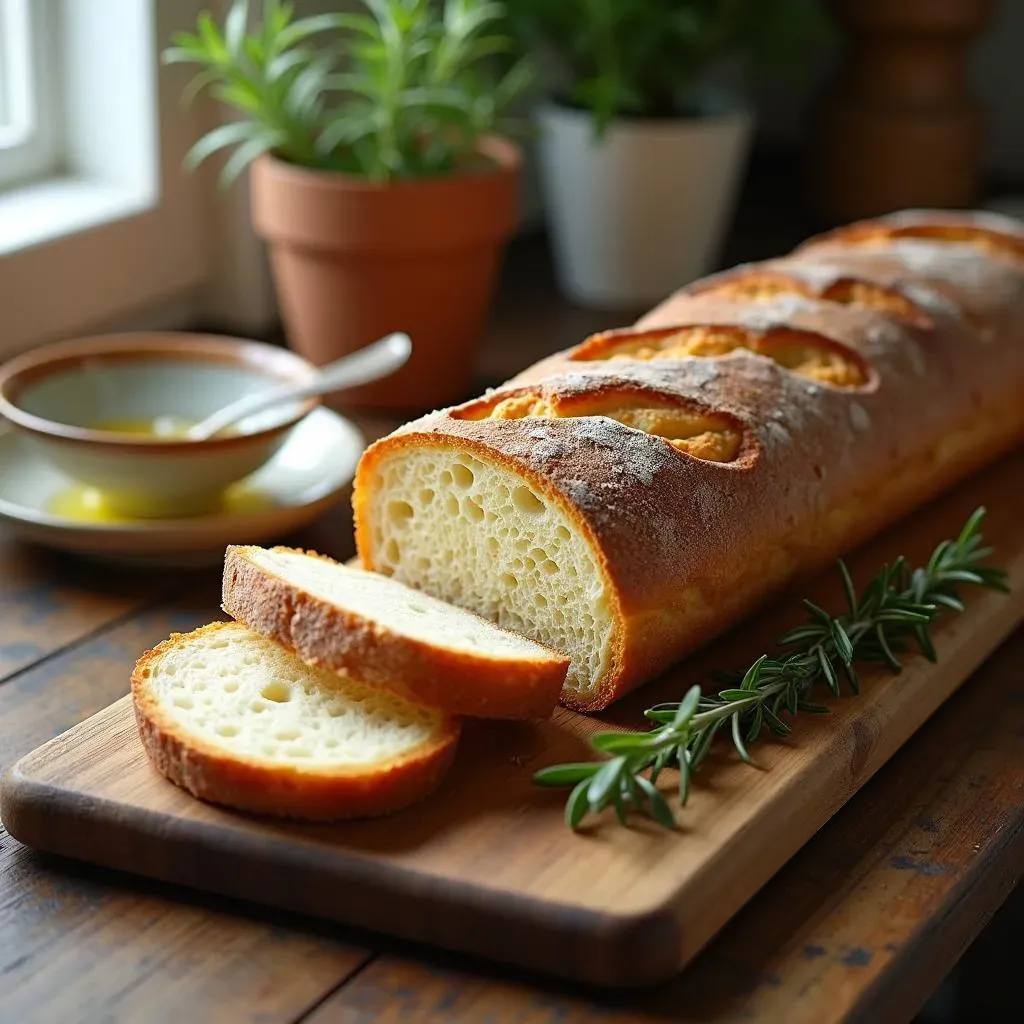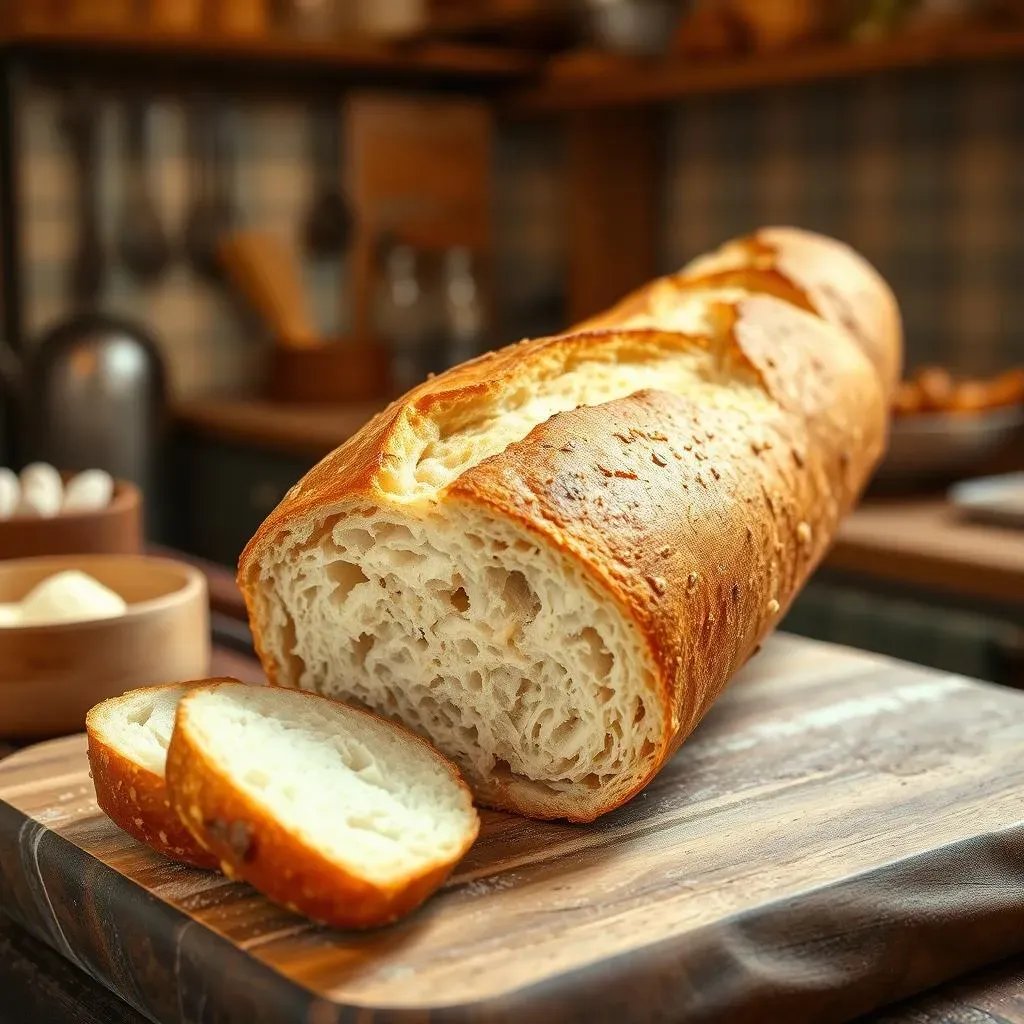Table of Contents
Ever dreamt of biting into a crusty, golden-brown baguette, the aroma of freshly baked bread filling your kitchen? Today, we'll unlock the secrets to achieving that dream with our comprehensive guide to the authentic French bread baguette recipe. Forget those disappointing supermarket loaves; this article empowers you to create bakery-quality baguettes right in your own home. We’ll take you on a journey, step-by-step, revealing the nuances of this classic recipe. First, we'll explore the essential ingredients and equipment needed to ensure success, from the type of flour to the right baking tools. Then, we'll dive into a detailed, easy-to-follow guide for making the perfect dough, covering techniques like kneading and proofing. Finally, we'll perfect the art of baking, ensuring your baguettes achieve that signature crispy crust and airy interior. Get ready to impress your friends and family with your newfound bread-making skills, and master the art of the authentic French bread baguette recipe.
Unlocking the Secrets of an Authentic French Bread Baguette Recipe

Unlocking the Secrets of an Authentic French Bread Baguette Recipe
The Allure of Authentic Baguettes
Let's be honest, store-bought baguettes often fall flat. They lack that certain *je ne sais quoi*—that perfect balance of crisp crust and chewy interior. The secret? It's all in the process. Authentic French baguettes aren't just baked; they're carefully crafted, a testament to time-honored techniques. We’re not talking about a quick 30-minute recipe; we're talking about a journey—a delicious journey, mind you—into the world of traditional French bread making. It's a journey worth taking, believe me. You'll be amazed by the results. And who knows, maybe you'll even discover a new passion for baking!
Think of it like this: a great baguette isn't just bread; it's an experience. It's the satisfying crunch of the crust, the soft yielding of the crumb, the earthy aroma that fills your senses. It's the culmination of simple ingredients transformed by time, technique, and a bit of love. Are you ready to embark on this culinary adventure? If you're looking for a quicker option, check out our French baguette bread machine recipe. But for the true authentic experience, keep reading!
Ingredient | Role |
|---|---|
High-protein flour | Provides structure and chewiness |
Water | Hydrates the dough and activates yeast |
Yeast | Fermentation and rise |
Salt | Flavor and dough strength |
The Importance of Technique
Beyond the ingredients, technique is key. The gentle kneading, the precise shaping, the careful scoring—these are the subtleties that elevate a good baguette to a great one. It’s a process that demands patience and attention, but the rewards are well worth the effort. Think of it as a meditative practice; each fold, each stretch, each careful manipulation contributes to the final masterpiece.
Many people are intimidated by the process of making authentic baguettes, but it's really not that hard. It just takes a little bit of practice. Once you get the hang of it, you'll be amazed at how easy it is to make delicious, homemade baguettes. And the best part? You get to control the ingredients. Want to add some herbs? Go for it! Want to use a different type of flour? Give it a try! The possibilities are endless. For a delicious twist, try our ultimate French baguette French toast recipe!
- Proper kneading develops gluten
- Careful shaping ensures even baking
- Precise scoring allows for optimal oven spring
Mastering the Bake
The final stage—the baking—is where the magic truly happens. The intense heat transforms the dough, creating that iconic crispy crust while maintaining a soft, airy interior. This is where the oven's temperature and the use of steam become crucial. It's a delicate balance—get it right, and you'll be rewarded with a perfect baguette. Get it wrong, and well... you might need to try again. But don't let that discourage you! Even experienced bakers have their baking mishaps.
The key to a successful bake is understanding your oven and adjusting accordingly. Every oven is different, and what works perfectly in one might not work in another. Experimentation is key here. Don't be afraid to tweak the baking time or temperature based on your oven's quirks. And don't forget the steam! It helps create that beautiful crust. Check out our French bread baguette recipe for more detailed baking instructions. Once you’ve mastered the technique, you can experiment with different types of flour and add-ins to create your own unique baguette variations. Happy baking!
Essential Ingredients and Equipment for Your Authentic French Bread Baguette Recipe

Essential Ingredients and Equipment for Your Authentic French Bread Baguette Recipe
Flour Power: The Foundation of Your Baguette
Let's start with the star of the show: flour. For an authentic baguette, you need high-protein flour, typically around 12-14%. This high protein content is crucial for developing the strong gluten network that gives baguettes their characteristic chewy texture. Don't skimp here; using all-purpose flour will result in a much denser, less satisfying loaf. Think of the flour as the muscle of your baguette; it's what gives it structure and that satisfying chew.
Choosing the right flour is half the battle. Different flours produce different results, so if you're aiming for that truly authentic taste and texture, investing in high-protein bread flour is essential. If you’re feeling adventurous, you can even try using a mix of different flours to experiment with flavor and texture. For a comprehensive comparison, check out our article on French bread vs. baguette.
Flour Type | Protein Content (%) | Resulting Texture |
|---|---|---|
All-purpose | 8-11 | Denser, less chewy |
Bread flour | 12-14 | Chewy, strong structure |
Yeast, Water, and Salt: The Holy Trinity of Baking
Next up, we have the essential trio: yeast, water, and salt. Active dry yeast is your go-to for reliable fermentation. The water you use should be lukewarm—not too hot, not too cold—to activate the yeast properly. Think of it as Goldilocks and the Three Bears, but with yeast instead of porridge. Too hot, and you'll kill the yeast; too cold, and it'll sleep on the job.
Salt is more than just a flavor enhancer; it plays a crucial role in dough development. It strengthens the gluten network, adds flavor complexity, and controls yeast activity. Don't be afraid to experiment with different types of salt—sea salt, kosher salt—to see how they affect the final flavor profile. For a deeper dive into the science of baking, check out our French baguette bread recipe, which explains the role of each ingredient in detail.
- Use lukewarm water to activate yeast
- Salt enhances flavor and dough strength
- Experiment with different salt types
Essential Equipment: Tools of the Trade
Finally, let's talk tools. While you don't need a fancy professional kitchen, having the right equipment makes a world of difference. A good mixing bowl, a sturdy scraper, and a baking sheet are essential. A lame (a specialized bread scoring tool) is highly recommended for creating those beautiful scoring patterns that help the baguette expand during baking. You can also use a sharp knife if you don’t have a lame.
A baking stone or steel is a game-changer. It provides even heat distribution and helps create a crispier crust. If you don't have a baking stone, a heavy baking sheet will work in a pinch. But trust me, the baking stone is worth the investment if you plan to bake baguettes regularly. A banneton (a proofing basket) is also very helpful for shaping the dough, but you can use a bowl lined with a floured tea towel as a substitute. For more tips and tricks on baking, check out our French baguette bread maker guide.
StepbyStep Guide: Baking the Perfect Authentic French Bread Baguette

StepbyStep Guide: Baking the Perfect Authentic French Bread Baguette
Mixing and Kneading the Dough
Start by combining your high-protein flour, lukewarm water, yeast, and salt in a large bowl. Mix gently until a shaggy dough forms. Then, it's time for the kneading! This is where the magic happens. Knead the dough for about 10-12 minutes until it becomes smooth and elastic. Don't worry if your arms get tired; it's worth the effort. You're building the gluten network that will give your baguette its structure. Think of it as a workout for your bread!
Once the dough is well-kneaded, shape it into a ball, place it in a lightly oiled bowl, cover it, and let it rise in a warm place for about 1-1.5 hours, or until doubled in size. This is called the bulk fermentation, and it's crucial for developing flavor and texture. You'll notice the dough become lighter and airier as it rises. During this time, you can relax and prepare your baking equipment. If you’re short on time, you can always use a bread machine; see our tips on using a French baguette bread machine for a quicker method.
Step | Description |
|---|---|
1 | Combine ingredients |
2 | Knead for 10-12 minutes |
3 | Bulk fermentation (1-1.5 hours) |
Shaping and Proofing Your Baguettes
Once the dough has risen, gently deflate it and divide it into three equal pieces. Shape each piece into a long baguette, about 12-14 inches long. This requires a bit of finesse, but don't be afraid to experiment. The goal is to create a smooth, evenly shaped loaf. Gently roll the dough to create a nice cylindrical shape. This step might seem tricky at first, but with a little practice, you'll master it in no time. For more detailed instructions, see our article on making French baguette bread.
Place your shaped baguettes on a floured couche (a linen cloth) or a baking sheet lined with parchment paper. Cover them loosely and let them proof for another 30-45 minutes. During this final proof, the baguettes will rise slightly, creating a beautiful, airy texture. The proofing process is important because it allows the dough to relax and develop its full flavor. Once they are proofed, it is time to score them. This step is critical for creating the signature look of a baguette and allowing it to expand properly during baking. Check out our post on Panera bread French baguette for tips on scoring.
- Divide dough into 3 equal pieces
- Shape into 12-14 inch baguettes
- Proof for 30-45 minutes
Baking to Perfection
Preheat your oven to 450°F (232°C) with a baking stone or steel inside. This high heat is crucial for creating that crispy crust. If you don’t have a baking stone, you can use a heavy baking sheet. Just be aware that the crust might not be as crispy. Once the oven is hot, carefully place your baguettes on the baking stone or sheet. Immediately spray some water into the oven to create steam; this helps develop the crust even further. If you don't have a spray bottle, you can place a pan of hot water on the bottom rack of the oven.
Bake for 20-25 minutes, or until the baguettes are golden brown and sound hollow when tapped on the bottom. Keep a close eye on them during baking, as ovens can vary. Once baked, carefully remove the baguettes from the oven and let them cool completely on a wire rack before slicing and serving. Enjoy the fruits of your labor! You've just baked authentic French baguettes. For more tips on achieving the perfect bake, check out our guide on French bread baguette pan baking.
